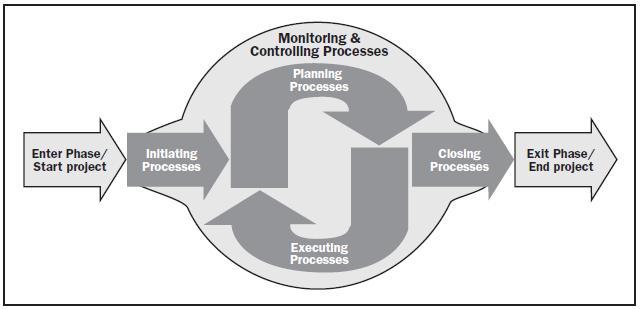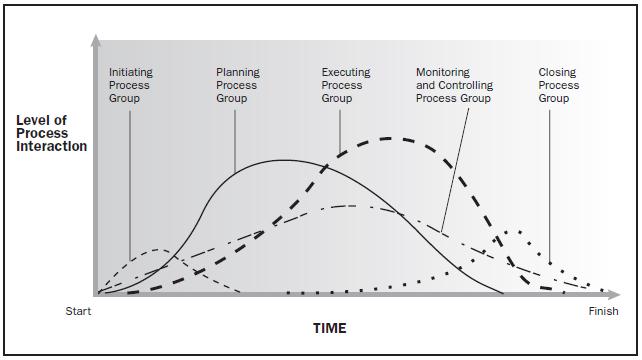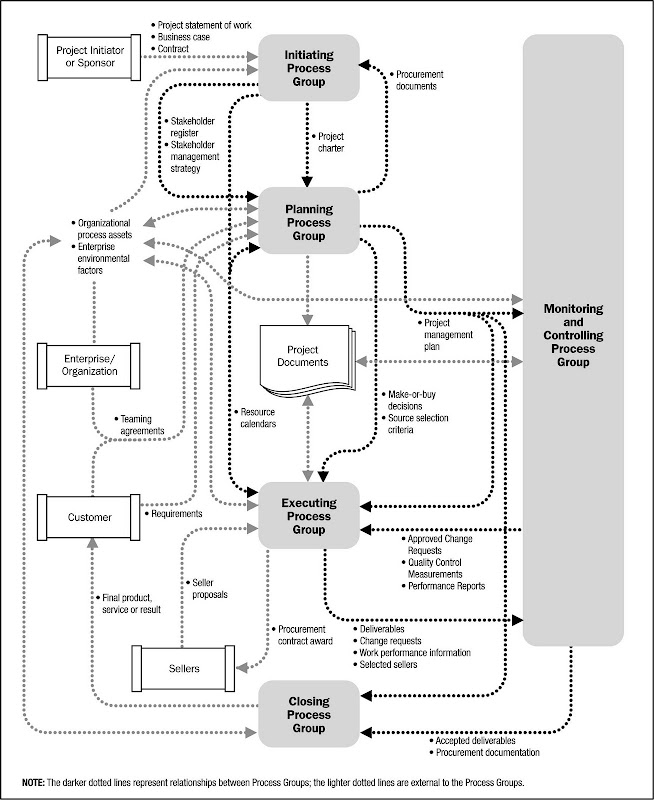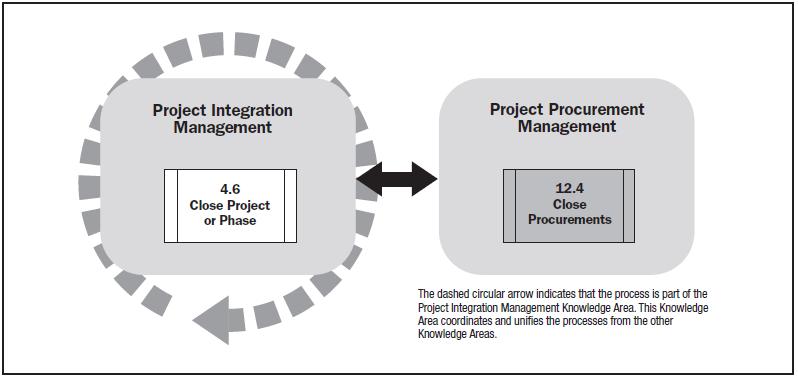Chapter 3 Project Management Processes For A Project
Project management is the application of knowledge, skills, tools, and techniques to project activities to meet project requirements.
This application of knowledge requires the effective management of appropriate processes.
A process is a set of interrelated actions and activities performed to achieve a pre-specified product, result, or service.
Each process is characterized by its inputs, the tools and techniques that can be applied, and the resulting outputs.
The project manager must consider organizational process assets and enterprise environmental factors.
These must be taken into account for every process, even if they are not explicitly listed as inputs in the process specification.
Organizational process assets provide guidelines and criteria for tailoring the organization’s processes to the specific needs of the project.
Enterprise environmental factors may constrain the project management options.
In order for a project to be successful, the project team must:
- Select appropriate processes required to meet the project objectives,
- Use a defined approach that can be adopted to meet requirements,
- Comply with requirements to meet stakeholder needs and expectations, and
- Balance the competing demands of scope, time, cost, quality, resources, and risk to produce the specified product, service, or result.
The project processes are performed by the project team and generally fall into one of 2 major categories:
- Project management processes ensure the effective flow of the project throughout its existence.
These processes encompass the tools and techniques involved in applying the skills and capabilities described in the Knowledge Areas (Chapters 4 through 12).
- Product-oriented processes specify and create the project’s product.
Product-oriented processes are typically defined by the project life cycle and vary by application area.
The scope of the project cannot be defined without some basic understanding of how to create the specified product.
- For example, various construction techniques and tools must be considered when determining the overall complexity of the house to be built.
This standard describes only the project management processes.
Although product-oriented processes are outside the scope of this standard, they should not be ignored by the project manager.
Project management processes and product-oriented processes overlap and interact throughout the life of a project.
Project management is an integrative undertaking requiring each project and product process to be appropriately aligned and connected with the other processes to facilitate coordination.
Actions taken during one process typically affect that process and other related processes.
- For example, a scope change typically affects project cost, but may not affect the communication plan or product quality.
These process interactions often require tradeoffs among project requirements and objectives, and the specific performance tradeoffs will vary from project to project and organization to organization.
Successful project management includes actively managing these interactions to meet sponsor, customer, and other stakeholder requirements.
In some circumstances, a process or set of processes will need to be iterated several times in order to achieve the required outcome.
Projects exist within an organization and cannot operate as a closed system.
They require input data from the organization and beyond, and deliver capabilities back to the organization.
The project processes may generate information to improve the management of future projects.
This standard describes the nature of project management processes in terms of the integration between the processes, their interactions, and the purposes they serve.
Project management processes are grouped into 5 categories known as Project Management Process Groups (or Process Groups):
- Initiating Process Group. Those processes performed to define a new project or a new phase of an existing project by obtaining authorization to start the project or phase.
- Planning Process Group. Those processes required to establish the scope of the project, refine the objectives, and define the course of action required to attain the objectives that the project was undertaken to achieve.
- Executing Process Group. Those processes performed to complete the work defined in the project management plan to satisfy the project specifications.
- Monitoring and Controlling Process Group. Those processes required to track, review, and regulate the progress and performance of the project;
identify any areas in which changes to the plan are required; and initiate the corresponding changes.
- Closing Process Group. Those processes performed to finalize all activities across all Process Groups to formally close the project or phase.
3.1 Common Project Management Process Interactions
The project management processes are presented as discrete elements with well-defined interfaces.
However, in practice they overlap and interact in ways that are not completely detailed here.
The required Process Groups and their constituent processes are guides for applying appropriate project management knowledge and skills during the project.
The application of the project management processes is iterative, and many processes are repeated during the project.
The integrative nature of project management requires the Monitoring and Controlling Process Group to interact with the other Process Groups.
In addition, since management of a project is a finite effort, the Initiating Process Group begins the project, and the Closing Process Group ends it.

Project Management Process Groups are linked by the outputs they produce.
The Process Groups are seldom either discrete or one-time events; they are overlapping activities that occur throughout the project.
The output of one process generally becomes an input to another process or is a deliverable of the project.
The Planning Process Group provides the Executing Process Group with the project management plan and project documents,
and, as the project progresses, it often entails updates to the project management plan and the project documents.
The following figure illustrates how the Process Groups interact and shows the level of overlap at various times.
If the project is divided into phases, the Process Groups interact within each phase.
In multi-phase projects, processes are repeated within each phase until the criteria for phase completion have been satisfied

3.2 Project Management Process Groups
These 5 Project Management Process Groups have clear dependencies and are typically performed in the same sequence on each project.
Individual Process Groups and individual constituent processes are often iterated prior to completing the project.
The constituent processes can have interactions within a Process Group and among Process Groups.
The process flow diagram provides an overall summary of the basic flow and interactions among Process Groups and specific stakeholders.
A Process Group includes the constituent project management processes that are linked by the respective inputs and outputs where the result or outcome of one process becomes the input to another.
The Process Groups are not project phases.
When large or complex projects are separated into distinct phases or subprojects such as feasibility study, concept development, design, prototype, build, test, etc.,
all of the Process Groups would normally be repeated for each phase or subproject.

The following table reflects the mapping of the 42 project management processes into the 5 Project Management Process Groups and the 9 Project Management Knowledge Areas.
The project management processes are shown in the Process Group in which most of the activity takes place.
- For example, when a process that normally takes place in the Planning Process Group is updated in the Executing Process Group, it is not considered a new process.
|
Process Groups
Knowledge Areas
|
Initiating
|
Planning
|
Executing
|
Monitoring &
Controlling
|
Closing
|
4. Integration
|
4.1 Develop Project Charter
|
4.2 Develop Project Management Plan
|
4.3 Direct and Manage Project Execution
|
4.4 Monitoring and Control Project Work
4.5 Perform Integrated Change Control
|
4.6 Close Project or Phase
|
5. Scope
|
|
5.1 Collect Reauirements
5.2 Define Scope
5.3 Create WBS
|
|
5.4 Verify Scope
5.5 Control Scope
|
|
6. Time
|
|
6.1 Define Activities
6.2 Sequence Activities
6.3 Estimate Activity Resources
6.4 Estimate Activity Durations
6.5 Develop Schedule
|
|
6.6 Control Schedule
|
|
7. Cost
|
|
7.1 Estimate Costs
7.2 Determine Budget
|
|
7.3 Control Cost
|
|
8. Quality
|
|
8.1 Plan Quality
|
8.2 Perform Quality Assurance
|
8.3 Perform Quality Control
|
|
9. Human Resource
|
|
9.1 Develop Human Resource Plan
|
9.2 Acquire Project Team
9.3 Develop Project Team
9.4 Manage Project Team
|
|
|
10. Communications
|
10.1 Identify Stakeholders
|
10.2 Plan Communications
|
10.3 Distribute Information
10.4 Manage Stakeholder Expectations
|
10.5 Report Performance
|
|
11. Risk
|
|
11.1 Plan Risk Management
11.2 Identify Risks
11.3 Perform Qualitative Risk Analysis
11.4 Perform Quantitative Risk Analysis
11.5 Plan Risk Response
|
|
11.6 Monitor and Control Risks
|
|
12. Procurement
|
|
12.1 Plan Procurements
|
12.2 Conduct Procurements
|
12.3 Administer Procurements
|
12.4 Close Procurements
|
3.3 Initiating Process Group
The Initiating Process Group consists of those processes performed to define a new project or a new phase of an existing project by obtaining authorization to start the project or phase.
Within the initiating processes, the initial scope is defined and initial financial resources are committed.
Internal and external stakeholders who will interact and influence the overall outcome of the project are identified.
If not already assigned, the project manager will be selected. This information is captured in the project charter and stakeholder register.
When the project charter is approved, the project becomes officially authorized.
Although the project management team may help write the project charter, approval and funding are handled external to the project boundaries.

As part of the Initiating Process Group, many large or complex projects may be divided into separate phases.
In such projects the Initiating processes are carried out during subsequent phases to validate the decisions made during the original Develop Project Charter and Identify Stakeholders processes.
Invoking the Initiating processes at the start of each phase helps keep the project focused on the business need the project was undertaken to address.
The success criteria are verified, and the influence and objectives of the project stakeholders are reviewed.
A decision is then made as to whether the project should be continued, delayed, or discontinued.
Involving the customers and other stakeholders during initiation generally improves the probability of shared ownership, deliverable acceptance, and customer and other stakeholder satisfaction.
Initiating processes may be performed by organizational, program, or portfolio processes external to the project’s scope of control.
Clear descriptions of the project objectives are developed, including the reasons why a specific project is the best alternative to satisfy the requirements.
The documentation for this decision may also contain the initial project scope statement, deliverables, project duration, and a forecast of the resources for the organization’s investment analysis.
As part of the Initiating processes the project manager is given the authority to apply organizational resources to the subsequent project activities.
The Initiating Process Group includes the following project management processes:

3.3.1 Develop Project Charter
Develop Project Charter is the process of developing a document that formally authorizes a project or a phase and documenting initial requirements that satisfy the stakeholder’s needs and expectations.
In multiphase projects, this process is used to validate or refine the decisions made during the previous iteration of Develop Project Charter.
3.3.2 Identify Stakeholders
Identify Stakeholders is the process of identifying all people or organizations impacted by the project, and documenting relevant information regarding their interests, involvement, and impact on project success.
3.4 Planning Process Group
The Planning Process Group consists of those processes performed to establish the total scope of the effort, define and refine the objectives, and develop the course of action required to attain those objectives.
The planning processes develop the project management plan and the project documents that will be used to carry out the project.
The multi-dimensional nature of project management creates repeated feedback loops for additional analysis.
As more project information or characteristics are gathered and understood, additional planning may be required.
Significant changes occurring throughout the project life cycle trigger a need to revisit one or more of the planning processes and, possibly, some of the initiating processes.
This progressive detailing of the project management plan is often called “rolling wave planning,” indicating that planning and documentation are iterative and ongoing processes.
The project management plan and project documents developed as outputs from the Planning Process Group will explore all aspects of the scope, time, costs, quality, communication, risk, and procurements.
Updates arising from approved changes during the project may significantly impact parts of the project management plan and the project documents.
Updates to these documents provide greater precision with respect to schedule, costs, and resource requirements to meet the defined project scope.
The project team should encourage involvement from all appropriate stakeholders when planning the project and developing the project management plan and project documents.
Since the feedback and refinement process cannot continue indefinitely, procedures set by the organization dictate when the initial planning effort ends.
These procedures will be affected by the nature of the project, the established project boundaries, appropriate monitoring and controlling activities, as well as the environment in which the project will be performed.
Other interactions among the processes within the Planning Process Group are dependent upon the nature of the project.
For example, for some projects there will be little or no identifiable risk until after significant planning has been done.
At that time, the team might recognize that the cost and schedule targets are overly aggressive, thus involving considerably more risk than previously understood.
The results of the iterations are documented as updates to the project management plan or project documents.
The Planning Process Group includes the project management processes:

3.4.1 Develop Project Management Plan
Develop Project Management Plan is the process of documenting the actions necessary to define, prepare, integrate, and coordinate all subsidiary plans.
The project management plan becomes the primary source of information for how the project will be planned, executed, monitored and controlled, and closed.
3.4.2 Collect Requirements
Collect Requirements is the process of defining and documenting stakeholders’ needs to meet the project objectives.
3.4.3 Define Scope
Define Scope is the process of developing a detailed description of the project and product.
3.4.4 Create WBS
Create Work Breakdown Structure is the process of subdividing project deliverables and project work into smaller, more manageable components.
3.4.5 Define Activities
Define Activities is the process of identifying the specific actions to be performed to produce the project deliverables.
3.4.6 Sequence Activities
Sequence Activities is the process of identifying and documenting relationships among the project activities.
3.4.7 Estimate Activity Resources
Estimate Activity Resources is the process of estimating the type and quantities of material, people, equipment, or supplies required to perform each activity.
3.4.8 Estimate Activity Durations
Estimate Activity Durations is the process of approximating the number of work periods needed to complete individual activities with estimated resources.
3.4.9 Develop Schedule
Develop Schedule is the process of analyzing activity sequences, durations, resource requirements, and schedule constraints to create the project schedule.
3.4.10 Estimate Costs
Estimate Costs is the process of developing an approximation of the monetary resources needed to complete project activities.
3.4.11 Determine Budget
Determine Budget is the process of aggregating the estimated costs of individual activities or work packages to establish an authorized cost baseline.
3.4.12 Plan Quality
Plan Quality is the process of identifying quality requirements and/or standards for the project and product, and documenting how the project will demonstrate compliance.
3.4.13 Develop Human Resource Plan
Develop Human Resource Plan is the process of identifying and documenting project roles, responsibilities, and required skills, reporting relationships, and creating a staffing management plan.
3.4.14 Plan Communications
Plan Communications is the process of determining project stakeholder information needs and defining a communication approach.
3.4.15 Plan Risk Management
Plan Risk Management is the process of defining how to conduct risk management activities for a project.
3.4.16 Identify Risks
Identify Risks is the process of determining which risks may affect the project and documenting their characteristics.
3.4.17 Perform Qualitative Risk Analysis
Perform Qualitative Risk Analysis is the process of prioritizing risks for further analysis or action by assessing and combining their probability of occurrence and impact.
3.4.18 Perform Quantitative Risk Analysis
Perform Quantitative Risk Analysis is the process of numerically analyzing the effect of identified risks on overall project objectives.
3.4.19 Plan Risk Responses
Plan Risk Responses is the process of developing options and actions to enhance opportunities and to reduce threats to project objectives.
3.4.20 Plan Procurements
Plan Procurements is the process of documenting project purchasing decisions, specifying the approach, and identifying potential sellers.
3.5 Executing Process Group
The Executing Process Group consist of those processes performed to complete the work defined in the project management plan to satisfy the project specifications.
This Process Group involves coordinating people and resources, as well as integrating and performing the activities of the project in accordance with the project management plan.
During project execution, results may require planning updates and re-baselining.
This can include changes to expected activity durations, changes in resource productivity and availability, and unanticipated risks.
Such variances may affect the project management plan or project documents and may require detailed analysis and development of appropriate project management responses.
The results of the analysis can trigger change requests that, if approved, may modify the project management plan or other project documents and possibly require establishing new baselines.
A large portion of the project’s budget will be expended in performing the Executing Process Group processes.
The Executing Process Group includes the following project management processes:

3.5.1 Direct and Manage Project Execution
Direct and Manage Project Execution is the process of performing the work defined in the project management plan to achieve the project’s objectives.
3.5.2 Perform Quality Assurance
Perform Quality Assurance is the process of auditing the quality requirements and the results from quality control measurements to ensure appropriate quality standards and operational definitions are used.
3.5.3 Acquire Project Team
Acquire Project Team is the process of confirming human resource availability and obtaining the team necessary to complete project assignments.
3.5.4 Develop Project Team
Develop Project Team is the process of improving the competencies, team interaction, and the overall team environment to enhance project performance.
3.5.5 Manage Project Team
Manage Project Team is the process of tracking team member performance, providing feedback, resolving issues, and managing changes to optimize project performance.
3.5.6 Distribute Information
Distribute Information is the process of making relevant information available to project stakeholders as planned.
3.5.7 Manage Stakeholder Expectations
Manage Stakeholder Expectations is the process of communicating and working with stakeholders to meet their needs and addressing issues as they occur.
3.5.8 Conduct Procurements
Conduct Procurements is the process of obtaining seller responses, selecting a seller, and awarding a contract.
3.6 Monitoring and Controlling Process Group
The Monitoring and Controlling Process Group consists of those processes required to track, review, and regulate the progress and performance of the project;
identify any areas in which changes to the plan are required; and initiate the corresponding changes.
The key benefit of this Process Group is that project performance is observed and measured regularly and consistently to identify variances from the project management plan.
The Monitoring and Controlling Process Group also includes:
- Controlling changes and recommending preventive action in anticipation of possible problems,
- Monitoring the ongoing project activities against the project management plan and the project performance baseline, and
- Influencing the factors that could circumvent integrated change control so only approved changes are implemented.
This continuous monitoring provides the project team insight into the health of the project and identifies any areas requiring additional attention.
The Monitoring and Controlling Process Group not only monitors and controls the work being done within a Process Group, but also monitors and controls the entire project effort.
In multi-phase projects, the Monitoring and Controlling Process Group coordinates project phases in order to implement corrective or preventive actions
to bring the project into compliance with the project management plan.
This review can result in recommended and approved updates to the project management plan.
For example, a missed activity finish date may require adjustments to the current staffing plan, reliance on overtime, or trade-offs between budget and schedule objectives.
The Monitoring and Controlling Process Group includes the following project management processes:

3.6.1 Monitor and Control Project Work
Monitor and Control Project Work is the process of tracking, reviewing, and regulating the progress to meet the performance objectives defined in the project management plan.
Monitoring includes status reporting, progress measurement, and forecasting.
Performance reports provide information on the project’s performance with regard to scope, schedule, cost, resources, quality, and risk, which can be used as inputs to other processes.
3.6.2 Perform Integrated Change Control
Perform Integrated Change Control is the process of reviewing all change requests, approving changes, and managing changes
to the deliverables, organizational process assets, project documents, and the project management plan.
3.6.3 Verify Scope
Verify Scope is the process of formalizing acceptance of the completed project deliverables.
3.6.4 Control Scope
Control Scope is the process of monitoring the status of the project and product scope and managing changes to the scope baseline.
3.6.5 Control Schedule
Control Schedule is the process of monitoring the status of the project to update project progress and managing changes to the schedule baseline.
3.6.6 Control Costs
Control Costs is the process of monitoring the status of the project to update the project budget and managing changes to the cost baseline.
3.6.7 Perform Quality Control
Perform Quality Control is the process of monitoring and recording results of executing the quality activities to assess performance and recommend necessary changes.
3.6.8 Report Performance
Report Performance is the process of collecting and distributing performance information including status reports, progress measurements, and forecasts.
3.6.9 Monitor and Control Risks
Monitor and Control Risks is the process of implementing risk response plans, tracking identified risks, monitoring residual risks, identifying new risks, and evaluating risk process effectiveness throughout the project.
3.6.10 Administer Procurements
Administer Procurements is the process of managing procurement relationships, monitoring contract performance, and making changes and corrections as needed.
3.7 Closing Process Group
The Closing Process Group consists of those processes performed to finalize all activities across all Project Management Process Groups to formally complete the project, phase, or contractual obligations.
At project or phase closure, the following may occur:
- Obtain acceptance by the customer or sponsor,
- Conduct post-project or phase-end review,
- Record impacts of tailoring to any process,
- Document lessons learned,
- Apply appropriate updates to organizational process assets,
- Archive all relevant project documents in the Project Management Information System (PMIS) to be used as historical data, and
- Close out procurements.
The Closing Process Group includes the following project management processes:

3.7.1 Close Project or Phase
Close Project or Phase is the process of finalizing all activities across all of the management Process Groups to formally complete the project or phase.
3.7.2 Close Procurements
Close Procurements is the process of completing each project procurement.
Comments (0)
You don't have permission to comment on this page.